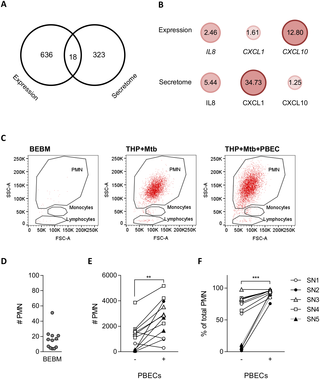PLoS Pathogens ( IF 6.7 ) Pub Date : 2017-09-01 , DOI: 10.1371/journal.ppat.1006577 Ann-Kathrin Reuschl 1 , Michael R Edwards 2 , Robert Parker 1 , David W Connell 1 , Long Hoang 1 , Alice Halliday 1 , Hannah Jarvis 1 , Nazneen Siddiqui 1 , Corrina Wright 3 , Samuel Bremang 1 , Sandra M Newton 4 , Peter Beverley 1 , Robin J Shattock 5 , Onn Min Kon 1 , Ajit Lalvani 1

|
Early events in the human airways determining whether exposure to Mycobacterium tuberculosis (Mtb) results in acquisition of infection are poorly understood. Epithelial cells are the dominant cell type in the lungs, but little is known about their role in tuberculosis. We hypothesised that human primary airway epithelial cells are part of the first line of defense against Mtb-infection and contribute to the protective host response in the human respiratory tract. We modelled these early airway-interactions with human primary bronchial epithelial cells (PBECs) and alveolar macrophages. By combining in vitro infection and transwell co-culture models with a global transcriptomic approach, we identified PBECs to be inert to direct Mtb-infection, yet to be potent responders within an Mtb-activated immune network, mediated by IL1β and type I interferon (IFN). Activation of PBECs by Mtb-infected alveolar macrophages and monocytes increased expression of known and novel antimycobacterial peptides, defensins and S100-family members and epithelial-myleoid interactions further shaped the immunological environment during Mtb-infection by promoting neutrophil influx. This is the first in depth analysis of the primary epithelial response to infection and offers new insights into their emerging role in tuberculosis through complementing and amplifying responses to Mtb.
中文翻译:

人原代上皮细胞的先天活化扩大了宿主对气道结核分枝杆菌的反应
人类气道中确定暴露于结核分枝杆菌(Mtb) 是否会导致感染的早期事件知之甚少。上皮细胞是肺中的主要细胞类型,但对其在结核病中的作用知之甚少。我们假设人类初级气道上皮细胞是抵御 Mtb 感染的第一道防线的一部分,并有助于人类呼吸道中的保护性宿主反应。我们模拟了这些早期气道与人类原发性支气管上皮细胞 (PBEC) 和肺泡巨噬细胞的相互作用。通过体外结合感染和 transwell 共培养模型与全局转录组学方法,我们确定 PBEC 对直接 Mtb 感染是惰性的,但在 Mtb 激活的免疫网络中是由 IL1β 和 I 型干扰素 (IFN) 介导的有效反应者。Mtb 感染的肺泡巨噬细胞和单核细胞激活 PBEC 增加了已知和新型抗分枝杆菌肽、防御素和 S100 家族成员的表达,并且上皮-髓样相互作用通过促进中性粒细胞流入进一步塑造了 Mtb 感染期间的免疫环境。这是对原发性上皮细胞对感染的反应的第一次深入分析,并通过补充和放大对 Mtb 的反应,对它们在结核病中的新兴作用提供了新的见解。



























 京公网安备 11010802027423号
京公网安备 11010802027423号